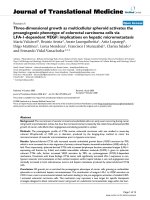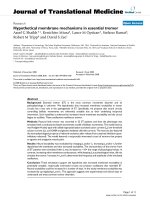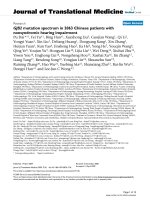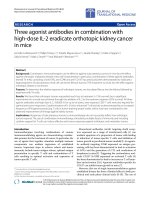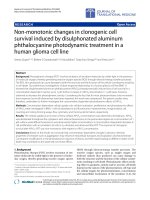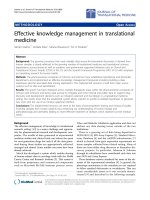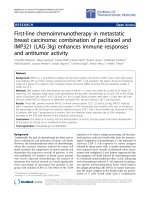Báo cáo hóa học: " Three agonist antibodies in combination with high-dose IL-2 eradicate orthotopic kidney cancer in mice" pptx
Bạn đang xem bản rút gọn của tài liệu. Xem và tải ngay bản đầy đủ của tài liệu tại đây (1.81 MB, 8 trang )
Westwood et al. Journal of Translational Medicine 2010, 8:42
/>Open Access
RESEARCH
BioMed Central
© 2010 Westwood et al; licensee BioMed Central Ltd. This is an Open Access article distributed under the terms of the Creative Com-
mons Attribution License ( which permits unrestricted use, distribution, and reproduc-
tion in any medium, provided the original work is properly cited.
Research
Three agonist antibodies in combination with
high-dose IL-2 eradicate orthotopic kidney cancer
in mice
Jennifer A Westwood
1,3
, Phillip K Darcy
1,2,3
, Preethi Mayura Guru
1,3
, Janelle Sharkey
1,3
, Hollie J Pegram
1,3
,
Sally M Amos
1,3
, Mark J Smyth
1,2,3
and Michael H Kershaw*
1,2,3
Abstract
Background: Combination immunotherapies can be effective against subcutaneous tumors in mice but the effect
against orthotopic malignant disease is less well characterized. In particular, a combination of three agonist antibodies,
termed Tri-mAb, consisting of anti-DR5, anti-CD40 and anti-CD137 has previously been demonstrated to eradicate a
large proportion of subcutaneous renal cell carcinoma (Renca) tumors (75% long-term survival), but the effect against
orthotopic disease is not known.
Purpose: To determine the relative response of orthotopic tumors, we inoculated Renca into the kidney followed by
treatment with Tri-mAb.
Results: We found that orthotopic tumors responded much less to treatment (~13% survival), but a significant
improvement in survival was achieved through the addition of IL-2 to the treatment regimen (55% survival). All three
agonist antibodies and high dose IL-2, 100,000 IU for up to six doses, were required. CD8
+
T cells were also required for
optimal anti-tumor responses. Coadministration of IL-2 led to enhanced T cell activity as demonstrated by an increased
frequency of IFN-gamma-producing T cells in tumor-draining lymph nodes, which may have contributed to the
observed improvement of therapy against kidney tumors.
Implications: Responses of subcutaneous tumors to immunotherapy do not necessarily reflect how orthotopic
tumors respond. The use of combination immunotherapy stimulating multiple facets of immunity and including
cytokine support for T cells can induce effective anti-tumor responses against orthotopic and metastatic tumors.
Introduction
Immunotherapies involving combinations of various
immunomodulating agents are demonstrating consider-
able promise for the treatment of cancer. In particular, the
use of agents that together stimulate multiple immune
components can mediate regression of established
tumors. Important steps to achieve robust anti-tumor
immunity include tumor antigen release, optimal antigen
presentation to specific T cells and costimulation of T
cells resulting in optimal activation and expansion of
tumor-specific T cells.
Monoclonal antibodies (mAb) targeting death recep-
tors expressed on a range of transformed cells [1] can
mediate apoptosis of a proportion of tumor cells leading
to induction of tumor-specific T cells and inhibition of
tumor growth in preclinical mouse models[2]. An agonis-
tic antibody targeting CD40 expressed on antigen pre-
senting cells has been demonstrated to lead to activation
of APCs and the generation of CTL and eradication of
lymphoma in mice[3]. Triggering the costimulatory mol-
ecule CD137 (4-1BB) expressed on activated T cells [4]
has been demonstrated to lead to increases in T cell num-
bers and activation [5,6]. Agonistic antibodies specific for
CD137 can inhibit tumor growth in mice [7].
However, this use of single immunomodulators against
established disease has been of limited effect in both pre-
clinical and early phase clinical trials [8-10]. The use of
* Correspondence:
1
Cancer Immunology Research Program, Peter MacCallum Cancer Centre,
Melbourne, Australia
Full list of author information is available at the end of the article
Westwood et al. Journal of Translational Medicine 2010, 8:42
/>Page 2 of 8
immunomodulating agents in combination with chemo-
therapy is demonstrating promise, and drug-induced
tumor apoptosis and immune-potentiation are thought to
play a role in therapy using combined agents [11,12].
Combinations of immune agonistic antibodies have
also demonstrated effectiveness against tumors of various
histologies when implanted subcutaneously. A combina-
tion of three antibodies targeting DR5, CD40 and CD137,
termed Tri-mAb, was able to induce complete regression
of syngeneic breast and kidney cancers located subcuta-
neously [13]. In another study using this combination
approach, NKT cell glycolipid ligands were demonstrated
to be able to substitute for CD40 ligation and induce
tumor regression [14]. A subsequent study demonstrated
that the inclusion of IL-21 in the treatment schedule
could enhance the efficacy of Tri-mAb therapy against
subcutaneous disease and small metastases [15].
Since tumor growth and responses can vary depending
on size and anatomical location, and established orthoto-
pic metastatic cancer is considered more difficult to treat
than subcutaneous disease, in the current study we
sought to determine the effect of Tri-mAb against estab-
lished orthotopic and metastatic renal cell carcinoma
without nephrectomy and ascertain if treatment could be
optimized using cytokine support.
Materials and methods
Cell lines and mice
Renca is a kidney cancer cell line of BALB/c mice [16].
This tumor cell line was maintained at 37°C and 5% CO
2
in RPMI medium, supplemented with 10% heat-inacti-
vated fetal calf serum (FCS) (Moregate Biotech, Bulimba,
QLD, Australia), 2 mM glutamine (JRH Biosciences,
Brooklyn, VIC, Australia), 100 U/ml penicillin, and 100
μg/ml streptomycin (both from Sigma, Castle Hill, NSW,
Australia).
BALB/c mice were purchased from The Walter and
Eliza Hall Institute of Medical Research, Melbourne, Aus-
tralia, and from Animal Resource Centre, Perth, Western
Australia. They were housed in specific pathogen free
conditions. Mice of 6 to 20 weeks of age were used in
experiments, and experiments were performed according
to The Peter MacCallum Cancer Centre Animal Experi-
mentation Ethics Committee guidelines.
Tumor growth in mice
BALB/c mice were inoculated subcapsule into the kidney
with 1 × 10
5
Renca cells. Treatment started 10 - 11 days
later, after randomization of mice into groups. Tri-mAb
consisted of a mixture of MD5.1 (anti-death receptor-5,
DR5), FGK-45 (anti-CD40) and 3H3 (anti-4-1BB) in equal
proportions. Each antibody was determined to be endo-
toxin free by LAL test. Different batches of the individual
mAbs of Tri-mAb were titrated in this study so that 50-
80% tumor regression of s.c. tumors was achieved, as
some batches of antibodies were toxic at the highest dose
of 100 μg each mAb per dose. Each dose of Tri-mAb was
injected intra-peritoneally every 3 - 4 days for a total of 3
doses. Other groups additionally received 100,000 IU
recombinant human IL-2 (NCI Preclinical Repository,
Frederick, MD, USA) in 200 μl PBS i.p. every day for up to
6 doses or until mice could not tolerate any more. Some
groups received PBS or control MAC4 rat IgG2a and
UC8-1B9 hamster IgG instead of Tri-mAb, at 100 μg each
mAb/200 μl/dose intra-peritoneally every 3 - 4 days for a
total of 3 doses. Tumor progression was determined by
survival of mice, which was defined as time until mice
became moribund, at which point they were euthanized.
Subcutaneous tumors were established by injection of 2 ×
10
5
Renca cells in 100 μl PBS into the abdominal area of
mice after fur in that area was trimmed. In some experi-
ments CD8
+
T cells were depleted using the mAb, clone
53.6.72, administered 200 μg 1 day prior to tumor injec-
tion and 100 μg on the day of tumor injection followed by
twice weekly injections of 100 μg for 24 days.
Intracellular IFN-γ assay
Mice were injected with 2 × 10
5
Renca s.c. into the upper
foot. Some groups received Tri-mAb on days 10 and 13,
and/or IL-2 at the dose of 100,000 IU/200 μl i.p. on days
10, 11 and 13. Control mice received MAC4 plus UC8-
1B9 i.p. On day 14, mice from each group were culled and
popliteal lymph node cells were harvested, teased
between forceps, filtered through a 70 μm filter, and indi-
vidually stimulated on anti-CD3 coated plates (0.13 μg
per well). 1 × 10
6
cells were placed in 0.5 ml media in a 48-
well plate. The plates were incubated for 18 hours at 37°C
in 5% CO
2
, and GolgiStop (BD Biosciences, San Jose, CA)
was added for the last 12 hours. Cells were harvested the
next day and stained and assessed by flow cytometry for
intracellular IFNγ using a Cytofix/Cytoperm Plus Fixa-
tion/Permeabilization kit (BC Biosciences Cat # 554715),
following the manufacturer's directions. Antibodies used
in this study were CD8α-FITC clone 53-6.7 (BD), TCRβ-
APC clone H57.597 (BD), and IFNγ-PE clone XMG1.2
(BD). Cells were analyzed by flow cytometry using a
FACS Calibur (BD).
Statistical analysis
Statistical analysis was performed with StatsDirect soft-
ware using Log rank analysis for comparing mouse sur-
vival data, and a Mann-Whitney Test for comparing
cytokine secretion from different treatment groups. Data
producing a P value of < 0.05 was considered to be signif-
icant.
Westwood et al. Journal of Translational Medicine 2010, 8:42
/>Page 3 of 8
Results
Tri-mAb therapy is less effective against tumors inoculated
into the kidney
Previous studies have demonstrated that administration
of Tri-mAb (anti-DR5 + anti-CD40 + anti-CD137) to
mice bearing subcutaneous Renca tumors regularly
resulted in complete regression of 50-80% (mean 70.8% ±
6.4) of tumors [13]. In order to determine if this degree of
effectiveness could be achieved against orthotopic meta-
static disease, we inoculated Renca directly into the kid-
ney and determined the effect of Tri-mAb on mouse
survival compared to mice bearing subcutaneous tumors.
Treatment with Tri-mAb began 10 days after inoculation
of Renca tumor cells, by which time s.c. tumors were
approximately 30 mm
2
in size, and primary kidney
tumors were approximately 10 mm
2
. Micrometastases
were also present at day 10 in the lungs of mice bearing
kidney tumors.
Non-treated mice, and those treated with isotype con-
trol mAb, died before day 30 after tumor inoculation as
demonstrated in two independent experiments (Figure
1). Mice bearing subcutaneous tumors survived signifi-
cantly longer than control mice, with 55% to 100% (mean
74.3% ± 13.6) of Tri-mAb-treated mice surviving long-
term. The survival of Tri-mAb-treated mice bearing kid-
ney tumors was significantly longer than control mice (P2
< 0.0001, Log-rank test), but significantly shorter than
mice with subcutaneous tumors that received Tri-mAb
(P2 = 0.034, Log-rank test for pooled data) (Figure 1).
Mice inoculated with subcutaneous tumors were culled
when tumors reached the ethically maximum ethically-
permitted size of 150 mm
2
. No metastases were present
in mice bearing subcutaneous tumors. Mice inoculated
with kidney tumors were culled when signs of stress
became evident, as indicated by lethargy and hunched,
ruffled appearance. Mice that died in groups inoculated
with kidney tumors all had large primary kidney tumors
and/or abdominal and lung metastases, as seen at
necropsy. Tri-mAb treatment of kidney tumor-bearing
mice generally resulted in 0% to 30% long-term survivors,
but it should be noted that in one experiment 75% of mice
eradicated kidney tumors following Tri-mAb treatment
(data not shown). It is not entirely clear why a large pro-
portion of mice survived in that experiment, although
Tri-mAb treatment was associated with considerable tox-
icity (weight loss and lethargy) in that case, suggesting
one or more antibodies in that batch of Tri-mAb was
unusually active.
The effectiveness of Tri-mAb against orthotopic kidney
cancer is enhanced by coadministration of high-dose IL-2
Since CD8
+
T cells were previously demonstrated to play
a crucial role in Tri-mAb therapy [13], we reasoned that
coadministration of the T cell growth factor, IL-2, may
enhance Tri-mAb therapy of orthotopic kidney cancer.
When Tri-mAb alone was used against 10-day-estab-
lished kidney cancer, a significant survival advantage of
mice was achieved P2 < 0.0001) but no mice survived
long-term (Figure 2). When high dose IL-2 was added to
the treatment regimen, a further significant survival
advantage over treatment with Tri-mAb alone was gained
(P2 < 0.0001), with approximately 65% now surviving
long-term beyond day 110.
In the experiments described above, we used high dose
IL-2 at 100,000 IU administered intraperitoneally daily
for 5 days. To determine if a similar enhancement of ther-
apy could be achieved with lower doses of IL-2, we
treated tumor-bearing mice with Tri-mAb in combina-
tion with low dose (10,000 IU) or medium dose (50,000
IU) or high dose (100,000 IU) IL-2 daily for 5 days and
monitored survival.
Figure 1 Tri-mAb is less effective against orthotopic kidney can-
cer than it is against subcutaneous tumors. Mice were injected with
Renca cells either subcutaneously (s.c.) (2 × 10
5
) or intrakidney (i.k.) (1
× 10
5
). On day 10 after tumor injection, some groups of mice received
Tri-mAb treatment consisting of 100 μg each of anti-DR5, anti-CD40
and anti-CD137 on days 10, 13 and 17. Other groups of mice received
control treatment consisting of isotype control antibodies (MAC4, rat
IgG2a; UC8-1B9, hamster IgG) or were left non-treated (NT), and surviv-
al monitored. Two representative experiments of three are shown A
and B. Control refers to non-treated in panel A and MAC4 rat IgG2a and
UC8-1B9 isotype controls for panel B. Survival of s.c. tumor-bearing
mice greater than mice with kidney tumors, P2 = 0.034 for pooled data
from A and B, Log-rank Test. (s.c. = subcutaneous tumor; i.k. = intrakid-
ney tumor).
Westwood et al. Journal of Translational Medicine 2010, 8:42
/>Page 4 of 8
Mice receiving Tri-mAb with low or medium dose IL-2
did not survive longer than mice receiving Tri-mAb alone
(Figure 3). Only with coadministration of high dose IL-2
was the survival of mice significantly increased beyond
those that received Tri-mAb alone. The enhanced sur-
vival was not due to high dose IL-2 alone since mice
receiving IL-2 alone did not survive longer than non-
treated mice.
All three antibodies are necessary for optimal anti-tumor
effects and treatment induces anti-tumor immunological
memory
To determine if all three antibodies were necessary for
the optimal enhancement of therapy by IL-2, groups of
mice were treated with each combination of two antibod-
ies and IL-2 and survival compared to mice receiving
three antibodies and IL-2. All treatment groups survived
longer than non-treated mice, but the largest proportion
of long-term surviving mice was in the group receiving all
three antibodies plus IL-2 (Figure 4).
Previous studies have shown that subcutaneous tumor-
bearing mice surviving long-term after Tri-mAb therapy
are resistant to tumor rechallenge, demonstrating immu-
nological memory formation against tumor-associated
antigens [13]. To determine if memory was similarly
invoked in mice bearing orthotopic kidney cancer follow-
ing the inclusion of IL-2 in the treatment regimen, we
rechallenged surviving mice with Renca (2 × 10
5
, subcu-
taneously).
All long-term surviving mice following treatment with
three doses of Tri-mAb alone or combination with IL-2
were resistant to tumor rechallenge, thereby demonstrat-
ing immunological memory against tumor (Figure 5).
Interestingly, in one experiment, mice received just one
injection of Tri-mAb (with or without IL-2) or three
injections of Tri-mAb (with or without IL-2), and when
long-term surviving mice from these groups were rechal-
lenged, only mice receiving IL-2 in addition to Tri-mAb
completely resisted rechallenge. Mice from the single
dose Tri-mAb alone group survived longer than control
naïve mice suggesting some degree of resistance, but
resistance was only complete in the group receiving coad-
ministration of IL-2 (Figure 5), suggesting that the inclu-
sion of IL-2 could enhance immunological memory
formation (P2 = 0.012, Log-rank test; Tri-mAb + IL-2 vs
Tri-mAb alone).
IL-2 increases the frequency of IFN-γ-producing T cells, and
CD8+ T cells are necessary for optimal anti-tumor activity
To gain insight into the mechanism of the increased anti-
tumor activity resulting from inclusion of IL-2 in therapy,
we determined the relative proportions of activated T
cells in tumor-draining lymph nodes. This was achieved
by determining the ability of T cells, freshly isolated from
Figure 2 Coadministration of IL-2 enhances the survival of mice bearing orthotopic kidney cancer. Groups of mice bearing 10-day established
kidney tumors were treated with either Tri-mAb alone (days 10, 14 and 18), IL-2 alone (10
5
IU i.p. daily for 4 to 6 days) or the combination of Tri-mAb
+ IL-2. Other groups were non-treated (NT). Numbers in parentheses depict the number of mice per group. Pooled results of 4 experiments are shown.
(P2 < 0.0001 for Tri-mAb + HD IL-2 vs Tri-mAb alone, Log-rank Test). (NT = non-treated, HD = high dose).
Westwood et al. Journal of Translational Medicine 2010, 8:42
/>Page 5 of 8
tumor-draining lymph nodes, to produce IFN-γ in
response to immobilized anti-CD3. Lymph nodes were
taken 4 days after the start of therapy (after 2 doses of Tri-
mAb and/or 3 doses of IL-2). While lymph nodes from
mice receiving control antibodies or IL-2 alone contained
less than 1% IFN-γ-producing T cells, lymph nodes from
Tri-mAb-treated mice had a significantly increased pro-
portion of IFN-γ
+
T cells (P2 = 0.002) (Figure 6), in agree-
ment with previously published data [13]. However, a
further significant increase in the frequency of IFN-γ-
producing T cells was afforded by the addition of IL-2 to
Tri-mAb therapy (P2 = 0.002) (Figure 6).
To confirm a role for T cells in the observed anti-tumor
activity of Tri-mAb + IL-2, cell-depleting antibodies were
administered to mice immediately prior to, and during
therapy. Since CD4
+
regulatory T cells have been shown
previously to play a role in tumor progression in this sys-
tem, we only used anti-CD8 to investigate a role for CD8
+
T cells. Depletion of CD8
+
T cells largely abrogated the
benefit of therapy (Figure 7), suggesting a major role for
CD8
+
T cells in the therapeutic activity of Tri-mAb + IL-
2.
Discussion
Experimental therapies developed on the basis of
responses of ectopic inoculation of tumor cells subcuta-
neously can be performed quickly and can teach us much
about the potential of various therapeutics and give us
mechanistic insight into therapeutic effects. Orthotopic
metastatic cancer models are more complex and are con-
sidered more difficult to treat than subcutaneous tumors.
One of the most promising therapies we have recently
encountered consists of three agonist antibodies (Tri-
mAb) administered systemically to mice bearing subcuta-
neous DR5
+
tumors. However, we did not know if the
remarkable tumor eradication rates of approximately 70%
could be achieved against orthotopic disease. In experi-
ments described herein, we found that orthotopic kidney
cancer was indeed much more difficult to treat than sub-
cutaneous disease, but response rates of mice bearing
orthotopic disease could be significantly raised (to ~55%)
by the addition of high dose IL-2 to the treatment regi-
men.
The reasons for poorer responses of orthotopic disease
to immunotherapy are not clear, but it is unlikely to sim-
Figure 3 Large doses of IL-2 are necessary for optimal anti-tumor activity. Mice with established orthotopic disease were treated with Tri-mAb
alone or in combination with various dose levels of IL-2 delivered in five doses as indicated. HD: high dose (10
5
IU); MD: medium dose (5 × 10
4
IU); LD:
low dose (10
4
IU). Numbers in parentheses depict number of mice per group. Experiment performed once, P < 0.018 for high-dose IL-2 vs lower doses
(Log-rank test).
Westwood et al. Journal of Translational Medicine 2010, 8:42
/>Page 6 of 8
ply be an issue of tumor burden, since subcutaneous
tumors are larger than the combined mass of primary
kidney tumors and micrometastases on day 10 after inoc-
ulation, and yet subcutaneous tumors respond better.
Possible reasons include differences in tumor microenvi-
ronment in which orthotopic disease and metastases
have a more immunosuppressive environment perhaps
mediated by regulatory cells and/or immunosuppressive
cytokines. Another potential reason may lie in inherent
differences in lymph nodes draining subcutaneous sites
and those draining internal sites. In any event, coadmin-
istration of IL-2 was demonstrated to increase the pro-
portion of T cells able to produce IFN-γ upon
stimulation, which likely contributed to the enhanced
therapeutic effect against orthotopic disease. This may
have reflected increases in the frequency or activity of
tumor associated antigen-specific T cells, but the specific
TAA are not known for Renca, and without this knowl-
edge it is technically difficult to demonstrate tumor-spe-
cific activity from freshly isolated lymphoid cells. In any
event, it is unlikely that fetal-calf serum antigens played a
role in the differential responses since cells injected into
both sites were cultured the same, and it is likely fetal calf
antigens were not present at the time of treatment since
tumors were established for 10 days before treatment.
Tri-mAb therapy is dependent on the expression of
DR5 on tumor cells, and ligation of DR5 is thought to
induce immunogenic cell death in a proportion of tumor
cells, thereby liberating TAA for recognition by the
immune system. Nevertheless, it is possible to extend this
type of therapy to DR5-refractory tumors by using some
chemotherapeutic agents that can also induce immuno-
genic cell death resulting in enhanced immune responses
against tumors when combined with anti-CD40 and anti-
CD137 [17,18]. Other orthotopic models of cancer do
exist including MC38 mouse colon carcinoma and,
although not established in our laboratory, it would be of
interest to determine if the current observations extend
to these models.
Other combination immunotherapies have demon-
strated potential for the eradication of large proportions
of established subcutaneous tumors in mice including the
use of Toll-like receptor agonists in combination with
anti-CD137 [19]. It would be of interest to determine if
coadministration of cytokine can enhance therapy against
more established subcutaneous disease or orthotopic dis-
ease in those settings.
Other forms of therapy have been demonstrated to
impact on orthotopic kidney cancer in mice, including the
use of IL-2 in combination with anti-CD40 [20] or IL-12
Figure 4 All three agonist antibodies are necessary in combination with IL-2 for optimal anti-tumor effects. Following intrakidney injection of
Renca cells, mice received the treatments listed as indicated by arrows. Some mice received the complete treatment of Tri-mAb + IL-2, whereas other
groups received various pairs of antibodies as listed either alone or in combination with IL-2. Some mice received no treatment to act as controls.
Numbers in parentheses depict number of mice per group. Results from a single experiment, P < 0.05 for three antibodies + IL-2 vs two antibodies +
IL-2 (Log-rank test), except for the comparison between Tri-mAb + IL-2 and MD5.1/CD40 + IL-2 which tended towards significance at P = 0.079.
Westwood et al. Journal of Translational Medicine 2010, 8:42
/>Page 7 of 8
[21] in the Renca system. However, part of the novelty of
our observations in the current study lie in the advanced
nature of orthotopic disease and the ability to produce a
large proportion of long-term survivors that have no evi-
dence of disease upon conclusion of experiments without
the need for surgical resection of the primary.
Coadministration of IL-2 has long been known to
enhance immunotherapies such as adoptive transfer of
tumor-specific T cells [22]. In addition, alternate cytok-
ines can be used with benefit in combination immuno-
therapies, including IL-15 [23] and IL-21 [15]. Since IL-2
can be associated with toxicity, it would be of interest to
determine if these cytokines can be of benefit against
orthotopic disease in the current model.
The reasons for the enhancement of therapy for IL-2
are not fully known, although there could be a contribu-
tion from increased effector function of T cells mediated
by IL-2 [24]. However, IL-2 has also been demonstrated
to play a role in the expansion of regulatory T cells [25],
and it would be of interest in future studies to determine
the effect of IL-2 on regulatory T cell numbers and func-
tion in this tumor model. Similarly, we have no insight
into the relative contribution of CD4
+
helper T cells in
this therapy or indeed if they are required at all once IL-2
has been exogenously provided, but it would be of inter-
est to derive such insight in future studies.
There are considerable challenges in the development
of optimal immunotherapies for cancer, and it is generally
of limited use to stimulate a single immune component,
rather it will likely be necessary to use several immune
modulators in concert that stimulate diverse immune
components such as antigen presentation and T cells,
together with activation of innate immune components
to produce site-specific inflammatory signals. The choice
Figure 5 Tri-mAb in combination with IL-2 induced anti-tumor
immunological memory. Long-term surviving mice were rechal-
lenged with a subcutaneous injection of Renca (2 × 10
5
cells) and sur-
vival monitored. Mice were derived from groups of kidney tumor-
bearing mice that received either 3 doses of Tri-mAb alone or in com-
bination with IL-2. Some mice came from groups receiving only one
dose of Tri-mAb with or without IL-2. A group of naive mice was also
injected subcutaneously with Renca as controls for tumor growth in
the absence of immunological memory. Numbers in parentheses de-
pict the number of mice per group. (P2 = 0.012, Log-rank test; Tri-mAb
+ IL-2 vs Tri-mAb alone).
Figure 6 Coadministration of IL-2 increases the frequency of IFN-
γ-producing T cells. Mice were injected subcutaneously with 2 × 10
5
Renca s.c. into the upper foot to enable isolation of popliteal lymph
nodes as distinct tumor-draining nodes. Some groups received Tri-
mAb i.p. on days 10 and 13, and/or IL-2 at the dose of 10
5
IU i.p. on days
10, 11 and 13. Control mice received MAC4 (rat IgG2a) plus UC8-1B9
(hamster IgG) i.p. On day 14, mice were culled and popliteal lymph
node cells stimulated on anti-CD3 antibody-coated plates with GolgiS-
top overnight. Each lymph node analyzed individually. Cells were har-
vested the next day and stained and assessed by flow cytometry for
intracellular IFNγ. Standard error of the mean is shown for 6 mice per
group.
Figure 7 CD8
+
T cells are necessary for optimal anti-tumor effects.
Mice were injected with 1 × 10
5
Renca i.k. and then treated with Tri-
mAb on day 11 only, and IL-2 at a dose of 10
5
IU i.p. on days 11 and 12.
Some mice received MAC 4 and UC8-1B9 antibodies as control treat-
ment. In addition, some groups received CD8-depleting mAb as de-
scribed in Materials and Methods. Results from a single experiment
with 8 mice per group, P = 0.035 for Tri-mAb + IL-2 vs CD8-depleted
Tri-mAb + IL-2 group (Log-rank test).
Westwood et al. Journal of Translational Medicine 2010, 8:42
/>Page 8 of 8
of appropriate tumor models also represent a challenge,
and while subcutaneous models can provide rapid
advances and direct further investigations, orthotopic
tumor models such as that described herein may provide
more physiologic settings in which to determine treat-
ment effectiveness and identify mechanisms. Indeed, the
data presented here suggests that the therapeutic efficacy
observed in subcutaneous models following immuno-
therapy may not extend to tumors in other locations. The
investigation of rationally designed combination immu-
notherapies in orthotopic models of malignancy may lead
to effective therapeutic options for cancer patients.
Competing interests
The authors declare that they have no competing interests.
Authors' contributions
JW contributed to experimental design and participated in all experiments and
helped draft the manuscript. PG, SA, PD and HP participated in orthotopic
implantation of tumors. JS produced monoclonal antibodies. MS and PD pro-
vided crucial reagents and intellectual input in experimental design and inter-
pretation. MK designed and assisted in the execution of experiments and data
interpretation, and wrote the manuscript. All authors read and approved the
final manuscript.
Acknowledgements
This work was supported by grants from The National Health and Medical
Research Council of Australia (NHMRC), The Cancer Council of Australia, The
Bob Parker Memorial Trust and the Peter MacCallum Cancer Centre Founda-
tion. M.K. is supported by a NHMRC Senior Research Fellowship. P.D. is sup-
ported by a NHMRC Career Development Award, and M.S. is supported by an
Australia Fellowship from the NHMRC.
Author Details
1
Cancer Immunology Research Program, Peter MacCallum Cancer Centre,
Melbourne, Australia,
2
Department of Pathology, University of Melbourne,
Australia and
3
Department of Immunology, Monash University, Clayton,
Australia
References
1. Nagata S: Apoptosis by death factor. Cell 1997, 88:355-365.
2. Takeda K, Yamaguchi N, Akiba H, Kojima Y, Hayakawa Y, Tanner JE, Sayers
TJ, Seki N, Okumura K, Yagita H, Smyth MJ: Induction of tumor-specific T
cell immunity by anti-DR5 antibody therapy. J Exp Med 2004,
199:437-448.
3. French RR, Chan HT, Tutt AL, Glennie MJ: CD40 antibody evokes a
cytotoxic T-cell response that eradicates lymphoma and bypasses T-
cell help. Nat Med 1999, 5:548-553.
4. Kwon BS, Weissman SM: cDNA sequences of two inducible T-cell genes.
Proc Natl Acad Sci USA 1989, 86:1963-1967.
5. Takahashi C, Mittler RS, Vella AT: Cutting edge: 4-1BB is a bona fide CD8 T
cell survival signal. J Immunol 1999, 162:5037-5040.
6. Wen T, Bukczynski J, Watts TH: 4-1BB ligand-mediated costimulation of
human T cells induces CD4 and CD8 T cell expansion, cytokine
production, and the development of cytolytic effector function. J
Immunol 2002, 168:4897-4906.
7. Murillo O, Arina A, Hervas-Stubbs S, Gupta A, McCluskey B, Dubrot J,
Palazon A, Azpilikueta A, Ochoa MC, Alfaro C, et al.: Therapeutic
antitumor efficacy of anti-CD137 agonistic monoclonal antibody in
mouse models of myeloma. Clin Cancer Res 2008, 14:6895-6906.
8. Advani R, Forero-Torres A, Furman RR, Rosenblatt JD, Younes A, Ren H,
Harrop K, Whiting N, Drachman JG: Phase I Study of the Humanized
Anti-CD40 Monoclonal Antibody Dacetuzumab in Refractory or
Recurrent Non-Hodgkin's Lymphoma. J Clin Oncol 2009.
9. Greco FA, Bonomi P, Crawford J, Kelly K, Oh Y, Halpern W, Lo L, Gallant G,
Klein J: Phase 2 study of mapatumumab, a fully human agonistic
monoclonal antibody which targets and activates the TRAIL receptor-
1, in patients with advanced non-small cell lung cancer. Lung Cancer
2008, 61:82-90.
10. Hotte SJ, Hirte HW, Chen EX, Siu LL, Le LH, Corey A, Iacobucci A, MacLean
M, Lo L, Fox NL, Oza AM: A phase 1 study of mapatumumab (fully
human monoclonal antibody to TRAIL-R1) in patients with advanced
solid malignancies. Clin Cancer Res 2008, 14:3450-3455.
11. Mom CH, Verweij J, Oldenhuis CN, Gietema JA, Fox NL, Miceli R, Eskens FA,
Loos WJ, de Vries EG, Sleijfer S: Mapatumumab, a fully human agonistic
monoclonal antibody that targets TRAIL-R1, in combination with
gemcitabine and cisplatin: a phase I study. Clin Cancer Res 2009,
15:5584-5590.
12. Leong S, Cohen RB, Gustafson DL, Langer CJ, Camidge DR, Padavic K, Gore
L, Smith M, Chow LQ, von Mehren M, et al.: Mapatumumab, an Antibody
Targeting TRAIL-R1, in Combination With Paclitaxel and Carboplatin in
Patients With Advanced Solid Malignancies: Results of a Phase I and
Pharmacokinetic Study. J Clin Oncol 2009.
13. Uno T, Takeda K, Kojima Y, Yoshizawa H, Akiba H, Mittler RS, Gejyo F,
Okumura K, Yagita H, Smyth MJ: Eradication of established tumors in
mice by a combination antibody-based therapy. Nat Med 2006,
12:693-698.
14. Teng MW, Westwood JA, Darcy PK, Sharkey J, Tsuji M, Franck RW, Porcelli
SA, Besra GS, Takeda K, Yagita H, et al.: Combined natural killer T-cell
based immunotherapy eradicates established tumors in mice. Cancer
Res 2007, 67:7495-7504.
15. Smyth MJ, Teng MW, Sharkey J, Westwood JA, Haynes NM, Yagita H,
Takeda K, Sivakumar PV, Kershaw MH: Interleukin 21 enhances antibody-
mediated tumor rejection. Cancer Res 2008, 68:3019-3025.
16. Murphy GP, Hrushesky WJ: A murine renal cell carcinoma. J Natl Cancer
Inst 1973, 50:1013-1025.
17. Teng MW, Sharkey J, McLaughlin NM, Exley MA, Smyth MJ: CD1d-based
combination therapy eradicates established tumors in mice. J Immunol
2009, 183:1911-1920.
18. Most RG van der, Currie AJ, Cleaver AL, Salmons J, Nowak AK, Mahendran
S, Larma I, Prosser A, Robinson BW, Smyth MJ, et al.: Cyclophosphamide
chemotherapy sensitizes tumor cells to TRAIL-dependent CD8 T cell-
mediated immune attack resulting in suppression of tumor growth.
PLoS One 2009, 4:e6982.
19. Westwood JA, Haynes NM, Sharkey J, McLaughlin N, Pegram HJ,
Schwendener RA, Smyth MJ, Darcy PK, Kershaw MH: Toll-Like Receptor
Triggering and T-Cell Costimulation Induce Potent Antitumor
Immunity in Mice. Clin Cancer Res 2009, 15:7624-7633.
20. Weiss JM, Back TC, Scarzello AJ, Subleski JJ, Hall VL, Stauffer JK, Chen X,
Micic D, Alderson K, Murphy WJ, Wiltrout RH: Successful immunotherapy
with IL-2/anti-CD40 induces the chemokine-mediated mitigation of an
immunosuppressive tumor microenvironment. Proc Natl Acad Sci USA
2009, 106:19455-19460.
21. Wigginton JM, Gruys E, Geiselhart L, Subleski J, Komschlies KL, Park JW,
Wiltrout TA, Nagashima K, Back TC, Wiltrout RH: IFN-gamma and Fas/FasL
are required for the antitumor and antiangiogenic effects of IL-12/
pulse IL-2 therapy. J Clin Invest 2001, 108:51-62.
22. Rosenberg SA, Spiess P, Lafreniere R: A new approach to the adoptive
immunotherapy of cancer with tumor-infiltrating lymphocytes.
Science 1986, 233:1318-1321.
23. Klebanoff CA, Finkelstein SE, Surman DR, Lichtman MK, Gattinoni L,
Theoret MR, Grewal N, Spiess PJ, Antony PA, Palmer DC, et al.: IL-15
enhances the in vivo antitumor activity of tumor-reactive CD8+ T cells.
Proc Natl Acad Sci USA 2004, 101:1969-1974.
24. Ley V, Langlade-Demoyen P, Kourilsky P, Larsson-Sciard EL: Interleukin 2-
dependent activation of tumor-specific cytotoxic T lymphocytes in
vivo. Eur J Immunol 1991, 21:851-854.
25. Zhang H, Chua KS, Guimond M, Kapoor V, Brown MV, Fleisher TA, Long LM,
Bernstein D, Hill BJ, Douek DC, et al.: Lymphopenia and interleukin-2
therapy alter homeostasis of CD4+CD25+ regulatory T cells. Nat Med
2005, 11:1238-1243.
doi: 10.1186/1479-5876-8-42
Cite this article as: Westwood et al., Three agonist antibodies in combina-
tion with high-dose IL-2 eradicate orthotopic kidney cancer in mice Journal
of Translational Medicine 2010, 8:42
Received: 12 January 2010 Accepted: 28 April 2010
Published: 28 April 2010
This article is available from: 2010 Westwood et al; lic ensee BioMed Central Ltd. This is an Open Access article distributed under the terms of the Creative Commons Attribution License ( ), which permits unrestricted use, distribution, and reproduction in any medium, provided the original work is properly cited.Journal of Translational Medicine 2010, 8:42

